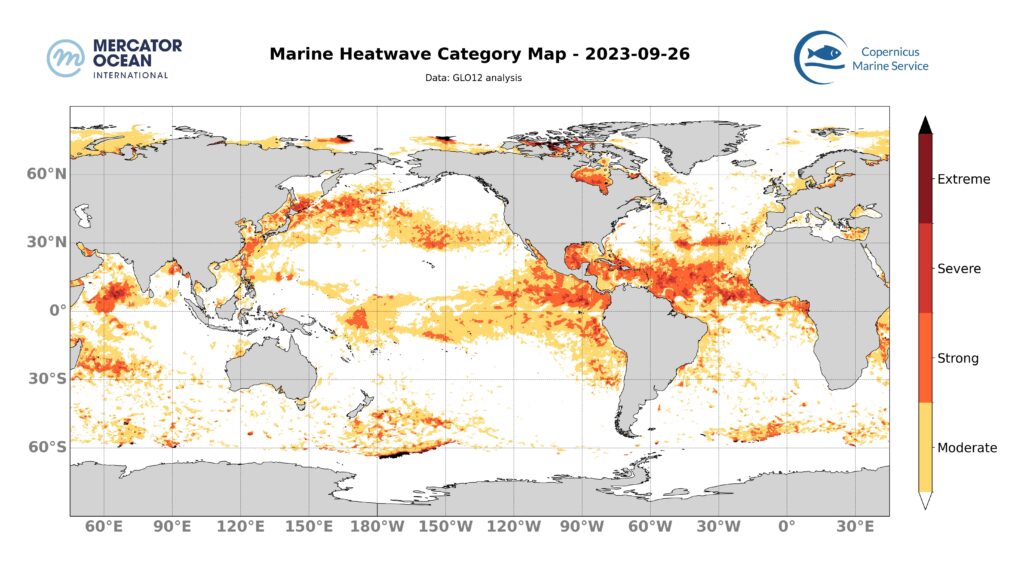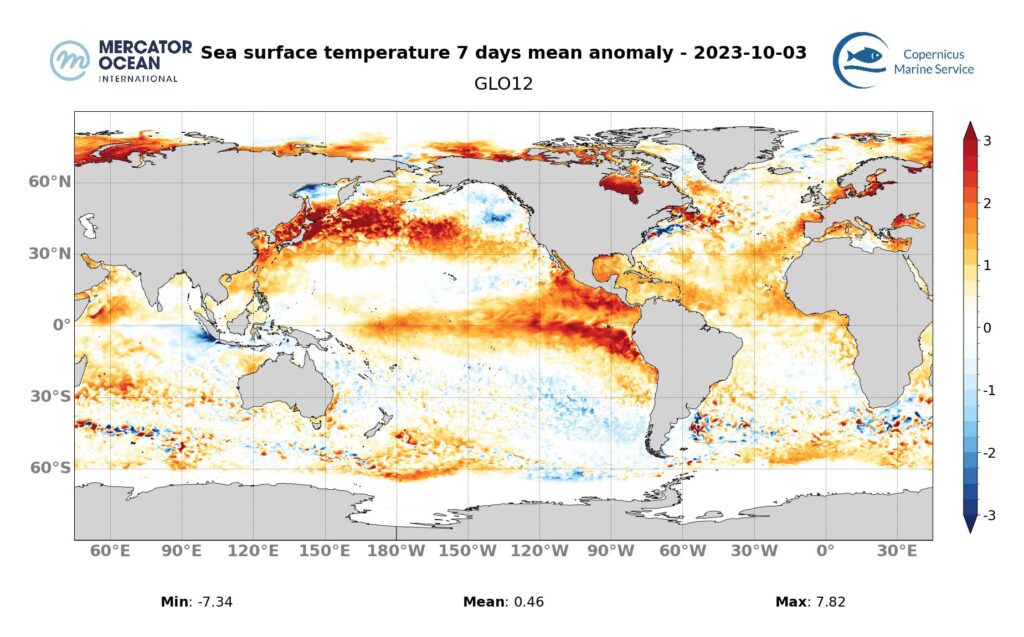Mercator Ocean International (MOi) oceanographers examine marine heatwaves across the global ocean. They analyse a variety of datasets from observation analyses (satellite sea surface temperature maps) to model analyses (assimilating satellite and in situ observations) and model forecasts.¹


Assessment for 26 September
- Europe zone:
- The marine heatwave is now only occurring very locally in the western Mediterranean, with a reduction in intensity to a moderate level, as well as in the eastern part of the basin.
- The same trend is occurring along the Atlantic front.
- The heatwave in the North Sea, in the Bay of Biscay and off the Iberian Peninsula are decreasing in extent and intensity to a moderate level.
- In the different European regions, the weekly temperature anomalies are between 1.5°C and 2.5°C. Around Ireland, the anomalies are around 0.5°C.
- Global area:
- In the Tropical Atlantic, the extent of the heatwave remains stable and its intensity is decreasing slightly. Most of the area remains in the high to severe category. The associated temperature anomalies are of the order of 1°C.
- The heatwave in the Gulf of Mexico remains in the moderate to severe category, but the northeastern part is losing intensity, falling into the moderate category. Weekly temperature anomalies are around 1.5°C.
- In the Tropical Pacific, the heatwave linked to the formation of El Niño persists. The extent of the strong category heatwave is increasing northwards. The weekly temperature anomaly in the eastern part of the basin is around 3°C. To the west of the basin, a strong category heatwave is strengthening over the Pacific islands.
- The heat wave that developed in the China Sea is easing slightly.
- The heatwave in the North-Eastern Pacific remains but becomes more pronounced in the centre of the basin, at the north of Hawaii, at a moderate, locally strong level, and disappears in the North-Eastern area, off the coast of North America. Weekly temperature anomalies are around 2°C over the central part, but can reach up to 3°C over the western part.
- In the western Indian Ocean, the heatwave is intensifying in the Arabian Sea, with strong to severe categories and weekly temperature anomalies of around 1°C.
Forecasts up to 3 October
- Europe zone :
- For October 3, Mercator Ocean International (MOI) forecasting system predicts the return of a moderate heatwave in the western Mediterranean. The trend is shown to be followed in the Bay of Biscay and off the Iberian Peninsula: the heatwave is increasing in area and intensity, with severe to locally extreme levels for the Iberian Peninsula. This wave extends beyond the European zone to the centre of the North Atlantic basin.
- Global zone:
- For October 3, Mercator Ocean International forecasts that the heatwave in the Tropical Atlantic will increase in intensity, with severe and extreme categories around the Caribbean and towards the coast of Africa.
- In the Northeast Tropical Pacific, the heatwave is strengthening in its northern part (off Mexico), reaching strong to severe categories.
- The heatwave in the North Pacific remains present in the centre of the basin.
- The heatwave in the western Indian Ocean is decreasing in intensity and geographical extent.
What are marine heatwaves?
Marine heatwaves (MHW) are extreme rises in ocean temperature for an extended period of time. They can occur at different locations in the ocean, and their magnitude and frequency have increased over the last couple of decades, with harmful impacts on ecosystems, and human activities. According to the latest report released by the Intergovernmental Panel on Climate Change (IPCC AR6 SYR), it is found with high confidence that in the near-term at 1.5°C global warming, the increasing frequency of marine heatwaves will increase risks of biodiversity loss in the oceans, including from mass mortality events.2
How are marine heatwaves calculated?
A marine heatwave is a heat episode during which the temperature is significantly higher than a certain threshold for at least 5 consecutive days.

The seasonally-varying threshold is defined on a daily basis according to a sufficiently long climatic period (in this case 1993-2016). So, for a given place and a given day, knowing all the surface temperatures observed over the last 30 years, a heatwave situation is defined as one where the temperature measured is within 10% of the maximum values observed (i.e. above the 90th quantile, see diagram), for at least 5 consecutive days.
The main characteristics of heatwaves are their duration and intensity. The intensity for a given day corresponds to the value in degrees above the 90th quantile (blue arrow), which can either be calculated as the cumulative intensity throughout the heatwave event, or the maximum intensity.
Heatwaves are categorised on the basis of their deviation from the mean temperature or anomaly (green arrow): a deviation of more than 2 times the difference between the 90th quantile and the mean corresponds to a heatwave in the strong category; a deviation of more than 3 times corresponds to a heatwave in the severe category; and a deviation of more than 4 times corresponds to a heatwave in the extreme category.
¹Analysis of datasets: OSTIA sea surface temperature observations analysis (Copernicus Marine Service), OISST sea surface temperature observations analysis (NOAA), GLO12 model (Copernicus Marine Service, Mercator Ocean International)
² IPCC AR6 SYR 4.3 https://www.ipcc.ch/report/ar6/syr/downloads/report/IPCC_AR6_SYR_LongerReport.pdf
